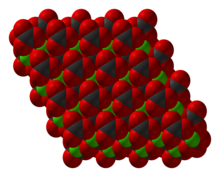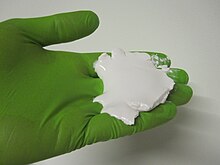
Back Mangaan(II)karbonaat AF كربونات المنغنيز الثنائي Arabic کربونات منقنز (II) AZB Uhličitan manganatý Czech Mangan(II)-carbonat German Mangana (II) karbonato EO Carbonato de manganeso Spanish کربنات منگنز (II) FA Mangaani(II)karbonaatti Finnish Carbonate de manganèse(II) French
 | |
 | |
| Names | |
|---|---|
| IUPAC name
Manganese(II) carbonate
| |
| Identifiers | |
3D model (JSmol)
|
|
| ChemSpider | |
| ECHA InfoCard | 100.009.040 |
| EC Number |
|
PubChem CID
|
|
| UNII | |
CompTox Dashboard (EPA)
|
|
| |
| |
| Properties | |
| MnCO3 | |
| Molar mass | 114.95 g mol−1 |
| Appearance | White to faint pink solid |
| Density | 3.12 g/cm3 |
| Melting point | 200–300 °C (392–572 °F; 473–573 K) decomposes[1][2] |
| negligible | |
Solubility product (Ksp)
|
2.24 x 10−11 |
| Solubility | soluble in dilute acid, CO2 insoluble in alcohol, ammonia |
| +11,400·10−6 cm3/mol | |
Refractive index (nD)
|
1.597 (20 °C, 589 nm) |
| Structure | |
| hexagonal-rhombohedral | |
| Thermochemistry | |
Heat capacity (C)
|
94.8 J/mol·K[2] |
Std molar
entropy (S⦵298) |
109.5 J/mol·K[2] |
Std enthalpy of
formation (ΔfH⦵298) |
-881.7 kJ/mol[2] |
Gibbs free energy (ΔfG⦵)
|
-811.4 kJ/mol[2] |
| Hazards | |
| Flash point | Non-flammable |
Except where otherwise noted, data are given for materials in their standard state (at 25 °C [77 °F], 100 kPa).
| |
Manganese carbonate is a compound with the chemical formula MnCO3. Manganese carbonate occurs naturally as the mineral rhodochrosite but it is typically produced industrially. It is a pale pink, water-insoluble solid. Approximately 20,000 metric tonnes were produced in 2005.[3]
- ^ Sigma-Aldrich Co., Manganese(II) carbonate. Retrieved on 2014-05-06.
- ^ a b c d e "Manganese(II) carbonate".
- ^ Arno H. Reidies (2007). "Manganese Compounds". Ullmann's Encyclopedia of Industrial Chemistry. Weinheim: Wiley-VCH. doi:10.1002/14356007.a16_123. ISBN 978-3527306732.